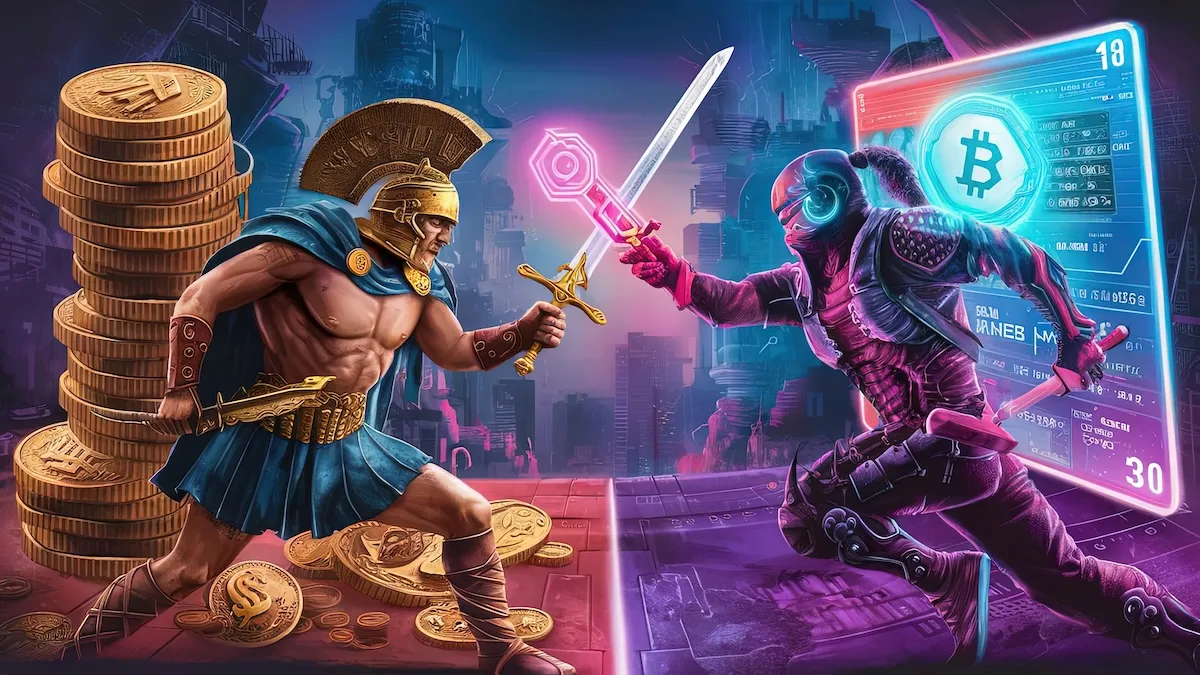The next crypto bull run won’t just be about Bitcoin or Layer 1 giants, it’ll be driven by gaming blockchains with real players, real ecosystems, and real utility. From high-speed performance to massive developer networks, these five platforms. Sui, Ronin, Polygon, Immutable, and Beam aren’t just hyped, they’re already building the future of Web3 gaming.
Key Takeaways
-
Sui brings ultra-fast parallel processing and the Move language to supercharge interactive, object-based game design.
-
Ronin is a battle-hardened chain built by Axie Infinity’s creators, now onboarding legacy gaming IPs.
-
Polygon leverages its AggLayer to unify chains and power cross-chain gaming on Ethereum.
-
Immutable X dominates NFT gaming infrastructure with over 625 games and gas-free transactions.
-
Beam, backed by Merit Circle DAO, is evolving into a dedicated gaming Layer 1 with deep industry integration.
Sui Network: Web3’s High-Performance Gaming Engine
Sui isn’t just another smart contract platformit’s purpose-built for gaming. Developed by Mysten Labs and launched in 2023, it uses a unique parallel execution engine combined with the Sui Move language. That means faster performance, dynamic NFTs, and complex gameplay mechanics that mimic real-world asset- onership.
Its object-centric model lets in-game assets evolve, interact, and own other objects. Think RPG characters upgrading weapons that also have their own histories. It’s tailor-made for developers who want to go beyond basic NFTs and create truly immersive games.
Sui’s ecosystem is ramping up with over 150,000 active addresses and games launching weekly, including titles from Orange Comet, Aether Games, and Worlds Beyond. Mysten Labs has formed over a dozen studio partnerships. Tools like the Sui Devnet and game SDK are simplifying onboarding.
Catalysts for 2025 include the SuiPlay 0X1 handheld console, designed to run blockchain-native games on-chain, and the introduction of dynamic NFTs, which will reshape game asset utility. Massive institutional backing from Coinbase Ventures, a16z, and Binance Labs adds legitimacy.
With an all-time high of $5.36 and more room to grow as adoption spreads, SUI offers both cutting-edge tech and high-upside potential. It’s a first-mover in object-based smart contracts and could redefine how assets function in Web3 gaming.
Ronin: The Proven Gaming Chain That Prints Revenue
Ronin has already done what many chains are trying to do: support a game that brought in millions of users. Built by Sky Mavis for Axie Infinity, it sidestepped Ethereum’s congestion by creating its own lightweight chain focused entirely on gaming.
Ronin now powers over $4.3 billion in NFT volume and has seen more than 17 million wallet downloads. Its infrastructure, including Katana DEX and Mavis Market, makes it a full-service chain for both players and developers.
In 2025, Ronin is transitioning from a niche to a mainstream platform. Recent partnerships with Act Games bring household brands like Hello Kitty, Zoids, and Bubble Bobble into the fold. These IPs have multigenerational appeal, offering a direct line to millions of traditional gamers.
Upcoming catalysts include the launch of permissionless development, which opens the Ronin ecosystem to all builders. The network is also deploying a $13 million DeFi fund, with a focus on staking, farming, and liquidity pools to drive TVL.
The RON token supports governance, validation, and staking—with rewards structured to incentivize long-term holding. It uses a DPoS model that enhances decentralization while maintaining throughput.
If you’re looking for a proven chain that has weathered the worst and is now expanding rapidly, Ronin is it. With new IPs, more games, and improved accessibility, the 2025 bull run could push RON well beyond its previous high.
Polygon: The Cross-Chain Powerhouse for Web3 Gaming
Polygon has evolved far beyond its MATIC roots. As Ethereum’s most advanced scaling solution, it powers thousands of dApps—and its focus on gaming has made it the go-to platform for developers seeking speed, interoperability, and low fees.
Polygon’s AggLayer, launched in 2025, is its masterstroke. It unites fragmented Layer 2 ecosystems, enabling seamless liquidity sharing and cross-chain gaming experiences. This means players can interact across games and platforms with minimal friction.
Its POL token introduces hyperproductive staking, allowing holders to secure multiple Polygon-powered chains and earn rewards from each. This structure encourages long-term engagement and aligns incentives between users and infrastructure.
Gaming partnerships are robust. The collaboration with Immutable zkEVM has yielded a game-optimized environment ideal for high-throughput transactions and NFT interoperability. Polygon is also home to studios and projects exploring dynamic gameplay, high-frequency trading, and esports integration.
Catalysts in 2025 include the Gigagas upgrade, which aims to achieve over 5,000 TPS by year-end. Polygon is also driving adoption with enterprise partnerships, including Stripe, BlackRock, and several legacy payment processors.
With prices still well below ATHs, POL offers upside from both gaming and broader DeFi and enterprise integrations. Its infrastructure-first approach makes it one of the most reliable plays in the space.
Immutable X: The NFT Gaming Giant
Immutable has quietly built the largest dedicated NFT gaming network in Web3. With over 625 games already integrated, including hits like Gods Unchained, Illuvium, and Guild of Guardians, it’s clear the platform has strong product-market fit.
The magic lies in its tech stack: zk-rollups from StarkWare power gas-free NFT minting and trading, all while maintaining Ethereum-level security. This allows developers to offer seamless player experiences without worrying about costs or congestion.
IMX is at the center of this ecosystem. It pays protocol fees, fuels staking rewards, enables governance, and even serves as in-game currency for many titles. Over 14 million IMX tokens are currently staked, showing high conviction from the community.
The big move in 2025 is the merger of Immutable X and zkEVM into a single unified chain: Immutable Chain. This gives developers EVM compatibility while preserving Immutable’s performance advantages. It also unlocks third-party DeFi tools, ERC-1155 liquidity, and better asset portability.
Game developers using Immutable benefit from the Immutable Passport, a frictionless identity and wallet solution, and the Global Orderbook, which ensures all NFT listings are instantly visible across marketplaces.
With new airdrops like Treeverse’s $END token rewarding stakers and institutional partnerships ramping up, IMX is primed to be the premier chain for NFT gaming. Price forecasts show potential gains of 250% to 350% in the near term.
Beam: The DAO-Powered Gaming L1 With Built-In Funding
Beam is the underdog that’s coming in hot. Created by Merit Circle DAO, Beam is focused solely on gaming and is backed by a treasury exceeding $100 million. This isn’t theory—it’s fully funded innovation.
Originally launched as an Avalanche subnet, Beam is now preparing for its Horizon upgrade that will transform it into an independent Layer 1. This means more decentralization, validator rewards, and a governance model controlled by the gaming community itself.
The Beam ecosystem includes over 60 active games, including Age of Battles, Space Nation, Goon Wars, and Megaweapon. Developers can use the Beam SDK and BeamOS to build and distribute games easily. Its Sphere Marketplace is tailor-made for NFT assets, offering a player-centric approach to asset trading.
The BEAM token isn’t just a gas token. It’s used for payments, staking, and DAO voting. More than 38% of the original supply has already been burned, adding serious deflationary momentum.
Upcoming catalysts include the launch of validator nodes, full staking functionality, and a major expansion to Immutable zkEVM, which will open the Beam ecosystem to even more users. With Avalanche Foundation support and a growing developer base, Beam is positioning itself as a real contender.
Still trading under $0.05, BEAM is the kind of asymmetric bet that can surprise everyone in the next market cycle if you catch it early enough.
Where the Next Wave Is Coming From
The next bull market won’t be driven by speculation alone. Real adoption, real users, and real games will be the key to breakout performance.
These five blockchains are already showing what’s possible when you mix smart infrastructure with visionary development. Whether it’s Sui’s dynamic NFTs, Ronin’s massive player base, Polygon’s multi-chain dominance, Immutable’s NFT expertise, or Beam’s DAO-driven growth, each has a unique edge.
They’re not betting on gaming. They are gaming. And as the market heats up, these tokens won’t stay cheap for long.
Watch them. Accumulate them. Or be left behind.
Frequently Asked Questions
Here are some frequently asked questions about this topic:
What is the best blockchain for gaming in 2025?
While each offers unique strengths, Sui and Immutable stand out for performance and NFT integration, while Ronin leads in mainstream adoption.
Which gaming blockchain has the most active users?
Ronin currently holds the edge with millions of wallet downloads and a proven track record supporting Axie Infinity’s massive user base.
What makes Sui different from other gaming blockchains?
Sui uses parallel processing and an object-based programming model with the Sui Move language, enabling dynamic, interactive game assets.
Is BEAM a good investment for gaming-focused crypto exposure?
Beam offers high upside potential with DAO backing, aggressive token burns, and over 60 games onboarded—though it’s still an emerging player.
How does Polygon support cross-chain gaming?
Polygon’s AggLayer allows seamless cross-chain asset and user transfers, making it ideal for developers building scalable and interoperable games.



